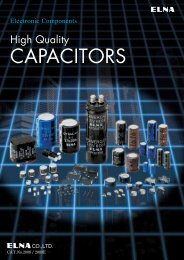Aluminum Electrolytic Capacitors
Aluminum Electrolytic Capacitors
Aluminum Electrolytic Capacitors
Create successful ePaper yourself
Turn your PDF publications into a flip-book with our unique Google optimized e-Paper software.
®ALUMINUM ELECTROLYTIC CAPACITORSTECHNICAL NOTEWITH CONDUCTIVE POLYMER SOLID ELECTROLYTE• Before transportation of electronic equipment tooverseas, fumigation process may be subjected towooden packing material with a halogen(compound) gas such as methyl bromide. Exercisecare that this halogen gas may corrode capacitors.Also, be careful of epidemic preventive agent ascorrosive component such as halogen may becontained.11. The case of solid conductive polymer aluminumelectrolytic capacitors and the cathode terminal arenot insulated.• The case and the cathode terminal are not insulatedas being connected through inconstant resistance.12. Double-sided PCB’s•When using capacitors on a double-sided PCB,exercise care that the wiring pattern does not touchthe area where the capacitors are mounted. Failureto do so may cause a short to occur to the PCBdepending on the mounting conditions.13. Regarding Connection of Solid ConductivePolymer <strong>Aluminum</strong> <strong>Electrolytic</strong> <strong>Capacitors</strong>• When connecting more than one capacitor inparallel, consider the current balance.14. Other Notes• Do not use capacitors on a circuit where rapidcharge and discharge are repeated.• Electrical characteristics of capacitors vary byvariations in temperature and frequency. Pleaseconsider these variations when designing a circuit.Cautions for Mounting1. Cautions for Mounting• Do not reuse capacitors that have been assembledin a set and energized. <strong>Capacitors</strong> cannot be reusedexcept for those which have been measured onelectrical performance during periodic inspection.• Before mounting, confirm the capacitor ratings(rated capacitance and rated voltage).• <strong>Capacitors</strong> may generate transient recovery voltage.In this case, discharge through a resistor of about1 k.• Before mounting, confirm the polarity of capacitor.• Do not drop capacitors onto a floor nor use them.• Do not mount deformed capacitors.• Do not mount heating parts around capacitors andon the back of the PCB under or back of capacitors).2. Do not apply excessive pressure to the capacitoror its terminals• Be careful of the shock force that can be producedby absorbers, product checkers, and centering onautomatic inserters and installers.3. Soldering• Do not solder capacitor body by dipping into meltedsolder.• Soldering conditions (preheating, solderingtemperature, terminal dipping time) should be withinthe ranges specified in the catalog or the deliveryspecification.• Flux should not adhere to the parts other than theterminals.• When using a soldering iron, avoid excessive stressto capacitor body.• In reflow soldering, the reflow should be conductedonce. Please be sure to consult with us if reflowmust be conducted twice.• Although leakage current may increase (from a fewµA to hundreds of µA) after soldering, it can bereduced through self-repair by applying voltage. It isadvised to operate the set properly after treatingwith the recommended voltage.• In case of a long-term use of equipment, control thesoldering characteristics so that capacitors and PCBdo not fail to connect to avoid abnormal currentpassage by a failure of soldering to mount.4. Handling after Soldering• Do not tilt, fall, raise or twist capacitor body.• Do not pick up or move PCB by holding a capacitor.• Do not bump capacitors against objects. Whenstacking PCB’s, make sure that capacitors do nottouch the PCB’s or other components.• Do not subject capacitors to excessive stress.5. Cleaning after Soldering• Recommended cleaning methodCleaning solutions:(a) CLEANTHROUGH 710M, 750H, 750L(b) PINEALPHA ST-100S(c) Techno Care FRW-4~17(d) Isopropyl alcohol (2-propanol)Cleaning conditions:(a) The temperature of cleaning solution shall beless than 60°C.(b) Use immersion or ultrasonic waves within twominutes.(c) After cleaning, capacitors and PCB’s shallthoroughly be rinsed and dried with hot blastfor more than 10 minutes. The temperature ofsuch breeze should be less than the uppercategory temperature.(d) After cleaning, do not keep capacitors incleaning solution atmosphere or airtightcontainers.CAT.No.2010/2011E






